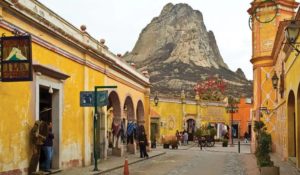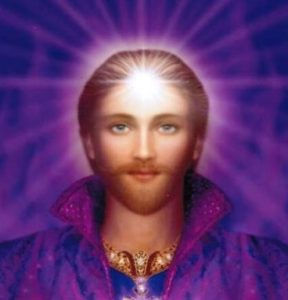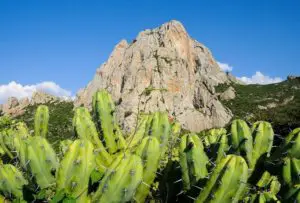Podcast: Play in new window | Download
Subscribe: Apple Podcasts | RSS
 Like Devil’s Tower in the 1977 movie “Close Encounters of the Third Kind,” the gigantic monolith called Peña de Bernal looms over the town of San Sebastián Bernal in the Mexican state of Querétaro. Perhaps even more mysterious than the massive rock in the Stephen Spielberg movie, Peña de Bernal is a first-class hotspot of all things paranormal in Mexico. From modern UFO sightings, to sacred ancient stories of the indigenous, to 21st Century urban legends, to mysterious lights and resonances, the monolith has something for everyone. Located near the center of the state of Querétaro about 35 miles northeast of the state’s capital city, some say that the gigantic rock is not only located in the center of the state, it is also located in the center of Mexico and the center of the world.
Like Devil’s Tower in the 1977 movie “Close Encounters of the Third Kind,” the gigantic monolith called Peña de Bernal looms over the town of San Sebastián Bernal in the Mexican state of Querétaro. Perhaps even more mysterious than the massive rock in the Stephen Spielberg movie, Peña de Bernal is a first-class hotspot of all things paranormal in Mexico. From modern UFO sightings, to sacred ancient stories of the indigenous, to 21st Century urban legends, to mysterious lights and resonances, the monolith has something for everyone. Located near the center of the state of Querétaro about 35 miles northeast of the state’s capital city, some say that the gigantic rock is not only located in the center of the state, it is also located in the center of Mexico and the center of the world.
Like Devil’s Tower, Peña de Bernal is a volcanic plug, essentially the remains of the center of the crater of an old volcano. The monolith is comprised mostly of dacite, a volcanic rock high in silica formed when lava cools rapidly. The silica composition of the rock has made the peña highly resistant to the weathering forces of rain and wind. The rock was originally thought to have formed during the Jurassic period some 175 million years ago. A chemical analysis used in a 2013 study of the rock by the National Autonomous University of Mexico, or UNAM, dated the formation of Peña del Bernal to 8.7 million years ago. The same UNAM study also put to rest once and for all the monolith’s official height. It towers 1,421 feet over the town of San Sebastián making it the tallest monolith in the world. It’s taller than the Rock of Gibraltar, found in the British Overseas Territory of Gibraltar on the southern coast of the Iberian Peninsula, which is 1,398 feet tall. It’s also taller than Sugarloaf Mountain in Brazil which stands at 1,299 feet. In many lists, even those repeated across the internet, especially on YouTube, Peña de Bernal is quoted as being the “third tallest” or “third largest” monolith behind Gibraltar and Sugarloaf. As far as sheer volume goes, Peña de Bernal doesn’t even make it on many of the lists of the top 25 monoliths. Actual volume of rock is hard to determine when many of the world’s gigantic stones are mostly under the surface. Uluru, or Ayer’s Rock, in the middle of Australia, is usually number one on the “largest monolith” lists.
The Otomi people, who have lived in the Mexican Altiplano for thousands of years, called Peña de Bernal, De’hendo, which translates to “The Middle of the Two.” No one knows why this place was christened such, but in the year 2009 the United Nations Educational, Scientific and Cultural Organization put the monolith on its list of Intangible Cultural Heritage of Humanity, calling it “The guardian of sacred territory” and a repository of indigenous memory of the Otomi-Chichimecas, thus recognizing the rock’s importance to the local people for millennia. When the Spanish arrived in the area in the early 1600s, they noticed the peña frequently hosted thousands of pilgrims who made a trek to the highest accessible point on the rock. A few chosen pilgrims would climb to the very top of the rock, which took much doing, especially when carrying a large stone cross. The early Spanish priests thought it curious that the Otomis, who had no previous exposure to Christianity, were having religious processions carrying large crosses. Later anthropologists would describe the crosses as representations of the Tree of Life or another plant symbol connected with the afterlife. Every May 4th to this day, the local indigenous people make this same pilgrimage their ancestors did, but nowadays, fully Catholicized, they carry a large wooden crucifix, as is typical in Mexico. So, from the time before the Spanish arrived, Peña de Bernal had already been seen as a very special place.
 Another pre-Hispanic tradition still carried out on the slopes of this great rock is the act of making offerings. There are certain indentations in the rock and small caves or overhangs on its slopes that lend themselves to shrines. Oftentimes tourists hiking Peña de Bernal are disgusted by what they think is excessive trash along the trails. Some of what they are seeing may be formal offerings to the local spirits or to natural phenomena such as the wind or rain. These offerings are made by natives and non-natives alike. There are even some who believe that chaneques, or a small race of elves, call the monolith their home and need to be kept happy through the giving of small gifts. For more information about chaneques, please see Mexico Unexplained episode number 59: https://mexicounexplained.com/alux-chaneque-mexicos-elusive-elves/ Modern-day visitors have claimed that they have also seen other so called “little people” on or around this gigantic rock in connection with UFO sightings. In the 21st Century some have claimed to have had face-to-face run-ins with what is known as the alien race called The Greys, a recognizable creature with a large head, black almond-shaped eyes, a slit for a mouth, spindly arms and legs and a skinny body. Any claims of sightings of these often nefarious and menacing extraterrestrials are dismissed by locals as mere sightings of chaneques, which, as previously alluded to, date back to long before Europeans arrived in Mexico.
Another pre-Hispanic tradition still carried out on the slopes of this great rock is the act of making offerings. There are certain indentations in the rock and small caves or overhangs on its slopes that lend themselves to shrines. Oftentimes tourists hiking Peña de Bernal are disgusted by what they think is excessive trash along the trails. Some of what they are seeing may be formal offerings to the local spirits or to natural phenomena such as the wind or rain. These offerings are made by natives and non-natives alike. There are even some who believe that chaneques, or a small race of elves, call the monolith their home and need to be kept happy through the giving of small gifts. For more information about chaneques, please see Mexico Unexplained episode number 59: https://mexicounexplained.com/alux-chaneque-mexicos-elusive-elves/ Modern-day visitors have claimed that they have also seen other so called “little people” on or around this gigantic rock in connection with UFO sightings. In the 21st Century some have claimed to have had face-to-face run-ins with what is known as the alien race called The Greys, a recognizable creature with a large head, black almond-shaped eyes, a slit for a mouth, spindly arms and legs and a skinny body. Any claims of sightings of these often nefarious and menacing extraterrestrials are dismissed by locals as mere sightings of chaneques, which, as previously alluded to, date back to long before Europeans arrived in Mexico.
Besides small humanoids, some people have also reported encounters with Saint Germain on the slopes of Peña de Bernal. Not recognized as a Catholic saint, Saint Germain was a wealthy European count who was the son of Prince Francis II of Transylvania. He dabbled in all things esoteric, including alchemy, and was known as a master of ancient wisdom. His followers claimed he was the reincarnation of several different important historical people, including a ruler of Atlantis, Plato, Christopher Columbus, Saint Joseph and the ancient English magician Merlin, among others. Saint Germain is revered as a great spiritual teacher within the Theosophy movement of the late 1800s which laid the foundation for the New Age movement that blossomed in the 1960s. Why this minor nobleman from Transylvania is appearing on a Mexican mountain is anyone’s guess, but Saint Germain sightings at Peña de Bernal most likely have to do with the type of modern foreign visitor who is drawn to the mountain. Interestingly, Saint Germain is associated with amethysts and the color violet. Some believe that the center of the Peña de Bernal is comprised of a gigantic amethyst crystal. Also, violet-colored orbs of light have been reported – and filmed – in the skies over San Sebastián Bernal, right near the famous monolith.
 In an August 2021 interview on the Mexican paranormal show, “Insólita Experiencia,” host Yohanan Díaz Vargas interviewed a woman named Lolita Vargas who has had many paranormal experiences in the area. Many years ago, she was assigned to visit the town of San Sebastián Bernal as part of her job, and she fell in love with the place. She bought property just outside of town in the very shadow of the monolith and now invites people to her land to experience the magic and mystery of the peña and surrounding area. Lolita Vargas calls the gigantic rock “the heart of the world” and claims that each human heart can connect to a universal intelligence through the monolith. Like many others, she believes the rock serves as a portal between dimensions and universes. The monolith also emits an incredible amount of life force energy. In the interview Lolita mentioned that the town at the rock’s base has more people over the age of 100 per capita than any other city or town in Mexico. The average life expectancy of the town is well over 90 years of age. At one point in the show Lolita claimed that the winds coming off the mountain are charged with a life force that causes everyone and everything around it to feel younger and more invigorated. She also added to the voices of those who claimed to have encounters on or around the rock with either strange creatures or Saint Germain. While meditating on her property in sight of the rock Lolita claimed to have received a vision from Ehecatl-Quetzalcoatl, the ancient Mesoamerican feathered serpent god in his wind aspect mode. In another meditation on the same spot, Lolita also claimed to have received messages from the spirit of Jacques de Molay, the last Grand Master of the Knights Templar. With all of this going on Lolita built what she calls a “medicine wheel” on her property which is a domed shelter reminiscent of a UFO. Inside that structure Lolita leads participants in silent meditation around a fire which she believes transmits information to humans. Each person makes offerings to the fire and prays to restore peace to earth. On August 14 and 15, 2021, Lolita Vargas hosted an event at Peña de Bernal called “Reactivating the Chakras of Mexico” which attracted dozens of people from Mexico and around the world.
In an August 2021 interview on the Mexican paranormal show, “Insólita Experiencia,” host Yohanan Díaz Vargas interviewed a woman named Lolita Vargas who has had many paranormal experiences in the area. Many years ago, she was assigned to visit the town of San Sebastián Bernal as part of her job, and she fell in love with the place. She bought property just outside of town in the very shadow of the monolith and now invites people to her land to experience the magic and mystery of the peña and surrounding area. Lolita Vargas calls the gigantic rock “the heart of the world” and claims that each human heart can connect to a universal intelligence through the monolith. Like many others, she believes the rock serves as a portal between dimensions and universes. The monolith also emits an incredible amount of life force energy. In the interview Lolita mentioned that the town at the rock’s base has more people over the age of 100 per capita than any other city or town in Mexico. The average life expectancy of the town is well over 90 years of age. At one point in the show Lolita claimed that the winds coming off the mountain are charged with a life force that causes everyone and everything around it to feel younger and more invigorated. She also added to the voices of those who claimed to have encounters on or around the rock with either strange creatures or Saint Germain. While meditating on her property in sight of the rock Lolita claimed to have received a vision from Ehecatl-Quetzalcoatl, the ancient Mesoamerican feathered serpent god in his wind aspect mode. In another meditation on the same spot, Lolita also claimed to have received messages from the spirit of Jacques de Molay, the last Grand Master of the Knights Templar. With all of this going on Lolita built what she calls a “medicine wheel” on her property which is a domed shelter reminiscent of a UFO. Inside that structure Lolita leads participants in silent meditation around a fire which she believes transmits information to humans. Each person makes offerings to the fire and prays to restore peace to earth. On August 14 and 15, 2021, Lolita Vargas hosted an event at Peña de Bernal called “Reactivating the Chakras of Mexico” which attracted dozens of people from Mexico and around the world.
Famous Mexican UFO experiencer Sixto Paz also has a lot to say about this gigantic monolith. He believes that a massive system of tunnels originates from the center of Peña de Bernal and radiates outward to many other sites of intense paranormal activity throughout Mexico. One of the tunnels goes directly to the seven craters located in the state of Guanajuato called Las Siete Luminarias, where strange creatures and UFOs have also been sighted frequently. For more information about this other paranormal hotspot please see Mexico Unexplained Episode 166 titled “The Mysterious Craters of Valle de Santiago.” https://mexicounexplained.com/the-mysterious-craters-of-valle-de-santiago/ Sixto Paz believes that the Peña de Bernal serves as a beacon for extraterrestrial craft and there are important reasons for these alien visitations. According to Sixto Paz, the UFOs are here to make changes in Mexico because in the not-so-distant future Mexico will be called to play an important role in the future transformation of the earth. Paz believes these encounters have been happening in this area for hundreds if not thousands of years, as evidenced by the many petroglyphs carved into or painted onto the mountain’s vast surface. Researchers have cataloged 15 distinct rock art sites on the monolith.
 In the year 2005 the Mexican government bestowed upon the town of San Sebastián Bernal “Pueblo Mágico” or “Magical Town” status. This put the town – and the monolith – on the map. Since then, people have been flocking to this place in droves, especially on the weekends. With the increased tourist traffic and an overall increased interest in the paranormal among the general population, a cottage industry has sprung up in town to cater to the UFO hunters, the New Agers and those seeking to understand the profound mysteries of the universe. The tourist must be careful, however, because the town has a few opportunists who impersonate curanderas or claim to be indigenous healers, even going as far as to create fake ancient shrines with cheesy artifact reproductions placed along “secret” back trails to give “special” visitors a unique experience, all for the price of 300 pesos. With so much genuine, fake, mysterious and otherwise inexplicable things going on around Peña de Bernal, this mighty Mexican monolith is the paranormal gift that keeps on giving.
In the year 2005 the Mexican government bestowed upon the town of San Sebastián Bernal “Pueblo Mágico” or “Magical Town” status. This put the town – and the monolith – on the map. Since then, people have been flocking to this place in droves, especially on the weekends. With the increased tourist traffic and an overall increased interest in the paranormal among the general population, a cottage industry has sprung up in town to cater to the UFO hunters, the New Agers and those seeking to understand the profound mysteries of the universe. The tourist must be careful, however, because the town has a few opportunists who impersonate curanderas or claim to be indigenous healers, even going as far as to create fake ancient shrines with cheesy artifact reproductions placed along “secret” back trails to give “special” visitors a unique experience, all for the price of 300 pesos. With so much genuine, fake, mysterious and otherwise inexplicable things going on around Peña de Bernal, this mighty Mexican monolith is the paranormal gift that keeps on giving.
REFERENCES
Gracias to Yohanan Diaz Vargas of “Insolita Experiencia” for his help with this.
